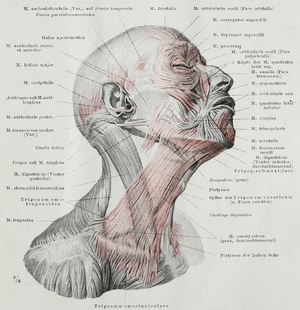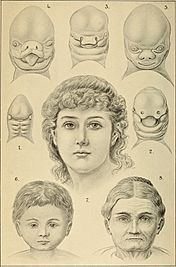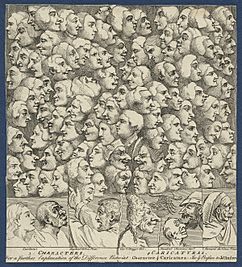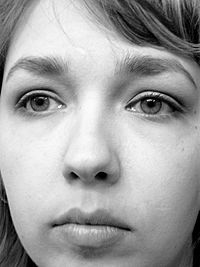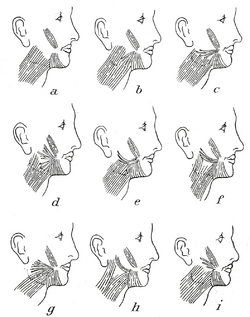Face facts for kids
The face is a part of the body at the front of the head.
It is the part of us that others interact with. On the face are organs of sight, smell, hearing. Especially in a four-legged animal, the face is the part which goes first into the world, and that is why the sense organs and the mouth are there.
In humans, the face includes the hair, forehead, eyebrow, eyelash, eyes, nose, ears, cheeks, mouth, lips, teeth, skin, and chin.
Contents
Structure
The front of the human head is called the face. It includes several distinct areas, of which the main features are:
- The forehead, comprising the skin beneath the hairline, bordered laterally by the temples and inferiorly by eyebrows and ears.
- The eyes sitting in the orbit and protected by eyelids, and eyelashes.
- The distinctive human nose shape, nostrils, and nasal septum.
- The cheeks covering the maxilla and mandibula (or jaw), the extremity of which is the chin.
- The mouth, with the upper lip divided by the philtrum, sometimes reveals the teeth.
Facial appearance is vital for human recognition and communication. Facial muscles in humans allow expression of emotions.
The face is itself a highly sensitive region of the human body and its expression may change when the brain is stimulated by any of the many human senses, such as touch, temperature, smell, taste, hearing, movement, hunger, or visual stimuli.
Shape
The face is the feature which best distinguishes a person. Specialized regions of the human brain, such as the fusiform face area (FFA), enable facial recognition; when these are damaged, it may be impossible to recognize faces even of intimate family members. The pattern of specific organs, such as the eyes, or of parts of them, is used in biometric identification to uniquely identify individuals.
The shape of the face is influenced by the bone-structure of the skull, and each face is unique through the anatomical variation present in the bones of the viscerocranium (and neurocranium). The bones involved in shaping the face are mainly the maxilla, mandible, nasal bone and zygomatic bone. Also important are various soft tissues, such as fat, hair and skin (of which color may vary).
The face changes over time, and features common in children or babies, such as prominent buccal fat-pads disappear over time, their role in the infant being to stabilize the cheeks during suckling. While the buccal fat-pads often diminish in size, the prominence of bones increase with age as they grow and develop.
Facial shape is an important determinant of beauty, particularly facial symmetry.
Function
Emotion
Faces are essential to expressing emotion, consciously or unconsciously. A frown denotes disapproval; a smile usually means someone is pleased. Being able to read emotion in another's face is "the fundamental basis for empathy and the ability to interpret a person’s reactions and predict the probability of ensuing behaviors". One study used the Multimodal Emotion Recognition Test to attempt to determine how to measure emotion. This research aimed at using a measuring device to accomplish what people do so easily everyday: read emotion in a face.
The muscles of the face play a prominent role in the expression of emotion, and vary among different individuals, giving rise to additional diversity in expression and facial features.
People are also relatively good at determining if a smile is real or fake. A recent study looked at individuals judging forced and genuine smiles. While young and elderly participants equally could tell the difference for smiling young people, the "older adult participants outperformed young adult participants in distinguishing between posed and spontaneous smiles". This suggests that with experience and age, we become more accurate at perceiving true emotions across various age groups.
Perception and recognition of faces

Gestalt psychologists theorize that a face is not merely a set of facial features, but is rather something meaningful in its form. This is consistent with the Gestalt theory that an image is seen in its entirety, not by its individual parts. According to Gary L. Allen, people adapted to respond more to faces during evolution as the natural result of being a social species. Allen suggests that the purpose of recognizing faces has its roots in the "parent-infant attraction, a quick and low-effort means by which parents and infants form an internal representation of each other, reducing the likelihood that the parent will abandon his or her offspring because of recognition failure". Allen's work takes a psychological perspective that combines evolutionary theories with Gestalt psychology.
Biological perspective
Research has indicated that certain areas of the brain respond particularly well to faces. The fusiform face area, within the fusiform gyrus, is activated by faces, and it is activated differently for shy and social people. A study confirmed that "when viewing images of strangers, shy adults exhibited significantly less activation in the fusiform gyri than did social adults". Furthermore, particular areas respond more to a face that is considered attractive, as seen in another study: "Facial beauty evokes a widely distributed neural network involving perceptual, decision-making and reward circuits. In those experiments, the perceptual response across FFA and LOC remained present even when subjects were not attending explicitly to facial beauty".
See also
 In Spanish: Cara para niños
In Spanish: Cara para niños




